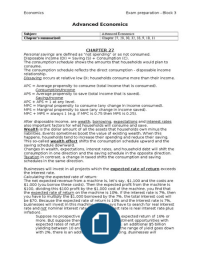Economics Exam preparation - Block 3
Advanced Economics
Subject: Advanced Economics
Chapter’s summarized: Chapter 27, 28, 30, 32, 33, 9, 10, 11
CHAPTER 27
Personal savings are defined as “not spending” or as not consumed.
Disposable income (DI) = Saving (S) + Consumption (C).
The consumption schedule shows the amounts that households would plan to
consume.
The consumption schedule reflects the direct consumption - disposable income
relationship.
Dissaving occurs at relative low DI; households consume more than their income.
APC = Average propensity to consume (total income that is consumed).
Consumption/Income
APS = Average propensity to save (total income that is saved).
Saving/Income
APC + APS = 1 at any level.
MPC = Marginal propensity to consume (any change in income consumed).
MPS = Marginal propensity to save (any change in income saved).
MPC + MPS = always 1 (e.g. if MPC is 0.75 then MPS is 0.25).
After disposable income, are wealth, borrowing, expectations and interest rates
also important factors for what households will consume and save.
Wealth is the dollar amount of all the assets that households own minus the
liabilities. Events sometimes boost the value of existing wealth. When this
happens, households tend to increase their spending and reduce their saving.
This so-called wealth effect shifts the consumption schedule upward and the
saving schedule downward.
Changes in wealth, expectations, interest rates, and household debt will shift the
consumption in one direction and the saving schedule in the opposite direction.
Taxation in contrast, a change in taxed shifts the consumption and saving
schedules in the same direction.
Businesses will invest in all projects which the expected rate of return exceeds
the interest rate.
Calculating the expected rate of return:
The net expected revenue from a machine is, let’s say, $1,100 and the costs are
$1,000 (you borrow these costs). Then the expected profit from the machine is
$100, dividing this $100 profit by the $1,000 cost of the machine, you find that
the expected rate of return on the machine is 10%. If the interest rate is 7%, then
you have to multiply the $1,000 borrowed by the 7%, the total interest cost will
be $70. Because the expected rate of return is 10% and the interest rate is 7%,
businesses will invest in this machine. You always have to search for real interest
rate and not nominal interest rate (nominal interest rate is real interest rate plus
inflation).
Suppose no prospective investments yield an expected return of 16% or
more. But suppose there are $5 billion of investment opportunities with
expected rates of return between 14 and 16%; an additional $5 billion
yielding between 10 and 12$ etc. Every time the range of yield goes down
with 2%, there is an additional $5 billion yielding. Businesses will
, Economics Exam preparation - Block 3
undertake investments when the expected rate of return equals the real
interest rate.
The inverse (downsloping) relationship between the interest rate (price) and the
dollar quantity of investment demanded conforms to the law of demand.
An increase in business taxes lowers the expected profitability of investments
and shifts the investment demand curve to the left.
The multiplier determines how much larger that change will be; it is the ratio of
a change in GDP to the initial change in spending.
Multiplier = Change in real GDP / Initial change in
spending
Change in GDP = Multiplier X initial change in spending
E.g. If investment in an economy rises by $30 billion and GDP increases by $90
billion > Multiplier = 3
Any change in income will change both consumption and saving in the same
direction as the change in income. E.g. if $5 billion increase in investment
spending occur and MPC = 0.75 and MPS = 0.25. Then consumption is increased
by $3.75 billion ($5 billion X 0.75) and savings is increased by $1.25
($5 billion X 0.25).
The MPC and the multiplier are directly related and the MPS and the
multiplier are inversely related.
Multiplier = - MPC
Multiplier = 1 / MPS
A large MPC (small MPS) means the succeeding rounds of consumption spending
diminish slowly and thereby cumulate to a large change in income.
CHAPTER 28
In the private closed economy, the two components of aggregate expenditures
(prices are fixed) are consumption, C, and gross investment, I g. Aggregate
expenditures consist of consumption plus investment, their sum makes up the
aggregate expenditures schedule. This schedule shows the amount (C+ Ig)
that will be spent at each possible output or income level. Aggregate
expenditures rise by $15 billion for every $20 billion increase in real ourput and
income, because $5 billion of each $20 billion increment is saved (MPC 0.75).
The equilibrium level of GDP is the level at which the total quantity of goods
produced (GDP) equals the total quantity of goods purchased (C + I g). Saving is a
leakage or withdrawal of spending from the economy’s circular flow of income
and expenditures. Saving is what causes consumption to be less than total output
or GDP. Investment - the purchases of capital goods - is therefore an injection of
spending into the income-expenditures stream.
We can say that aggregate expenditures for a private open economy are: C +
I g + X n.
E.g. international trade increases equilibrium GDP from $470 billion in the private
closed economy to $490 billion. Adding net exports of $5 billion has increased
GDP by $20 billion, in this case implying a multiplier of 4.
Finally you can add government investments to the aggregate expenditures. So
finally aggregate expenditures are: C + Ig + Xn + G. E.g. the MPC and MPS tell
us how much consumption and saving will decline as a result of the $20 billion in
taxes. Because the MPC is 0.75, the government tax collection of $20 billion will





